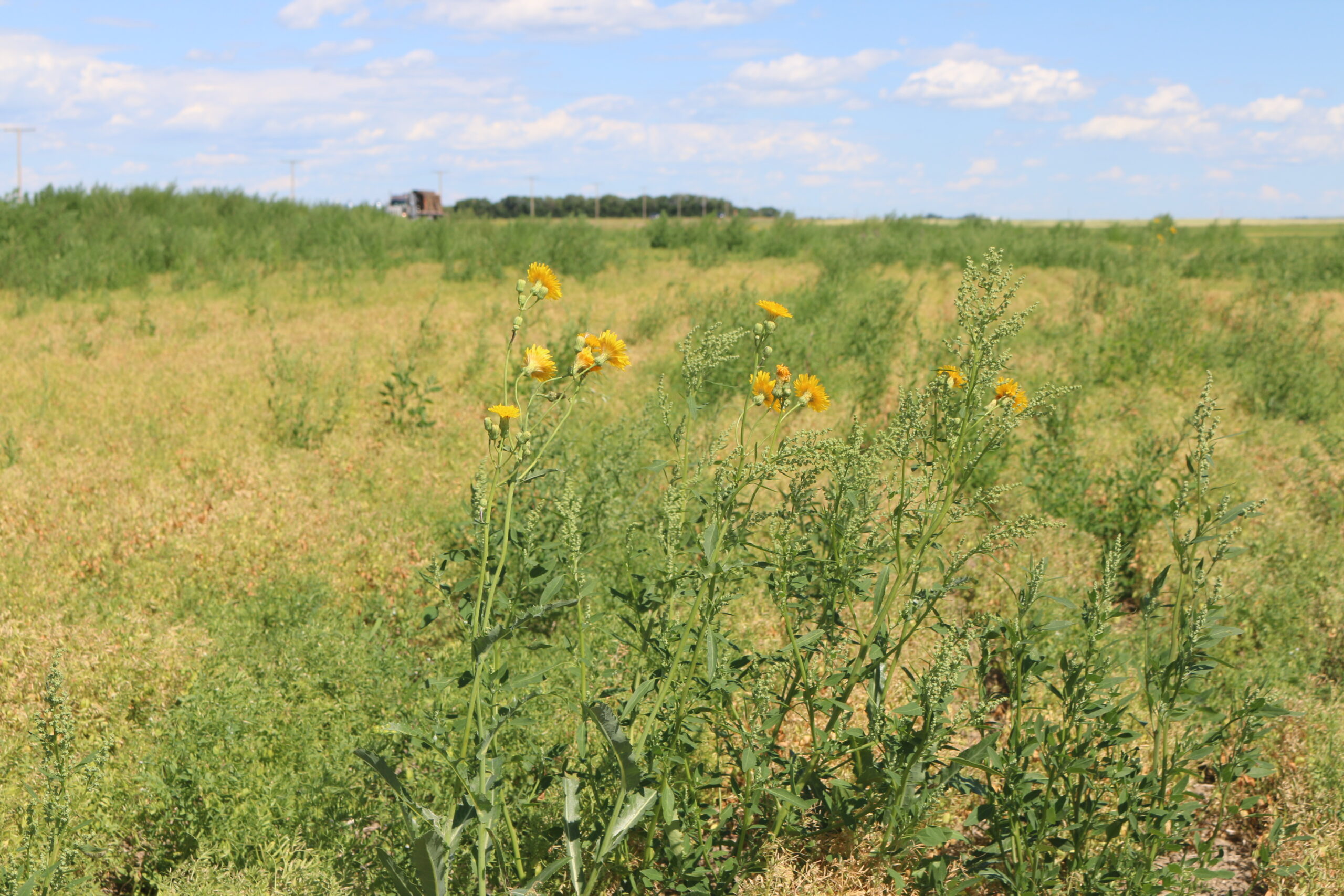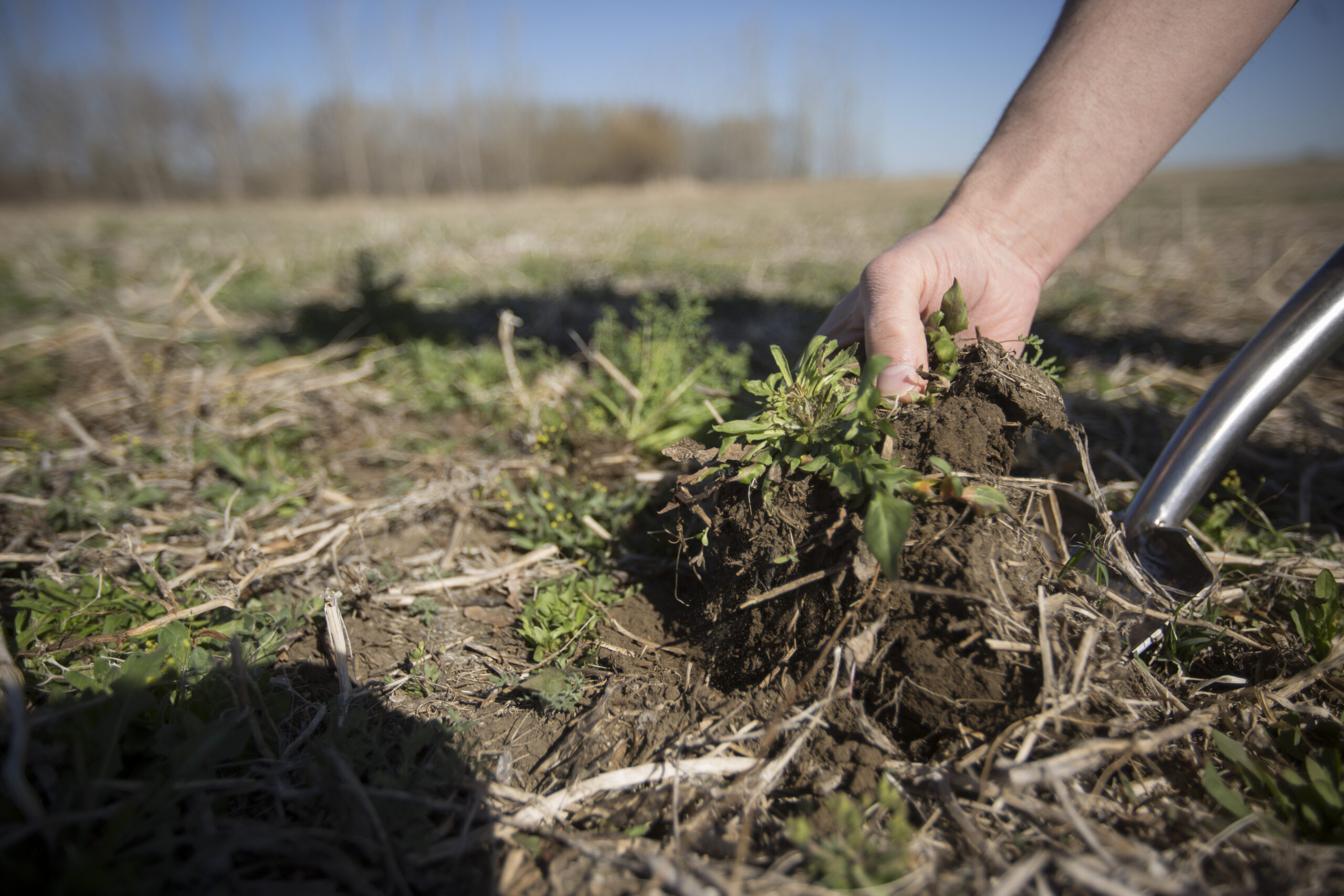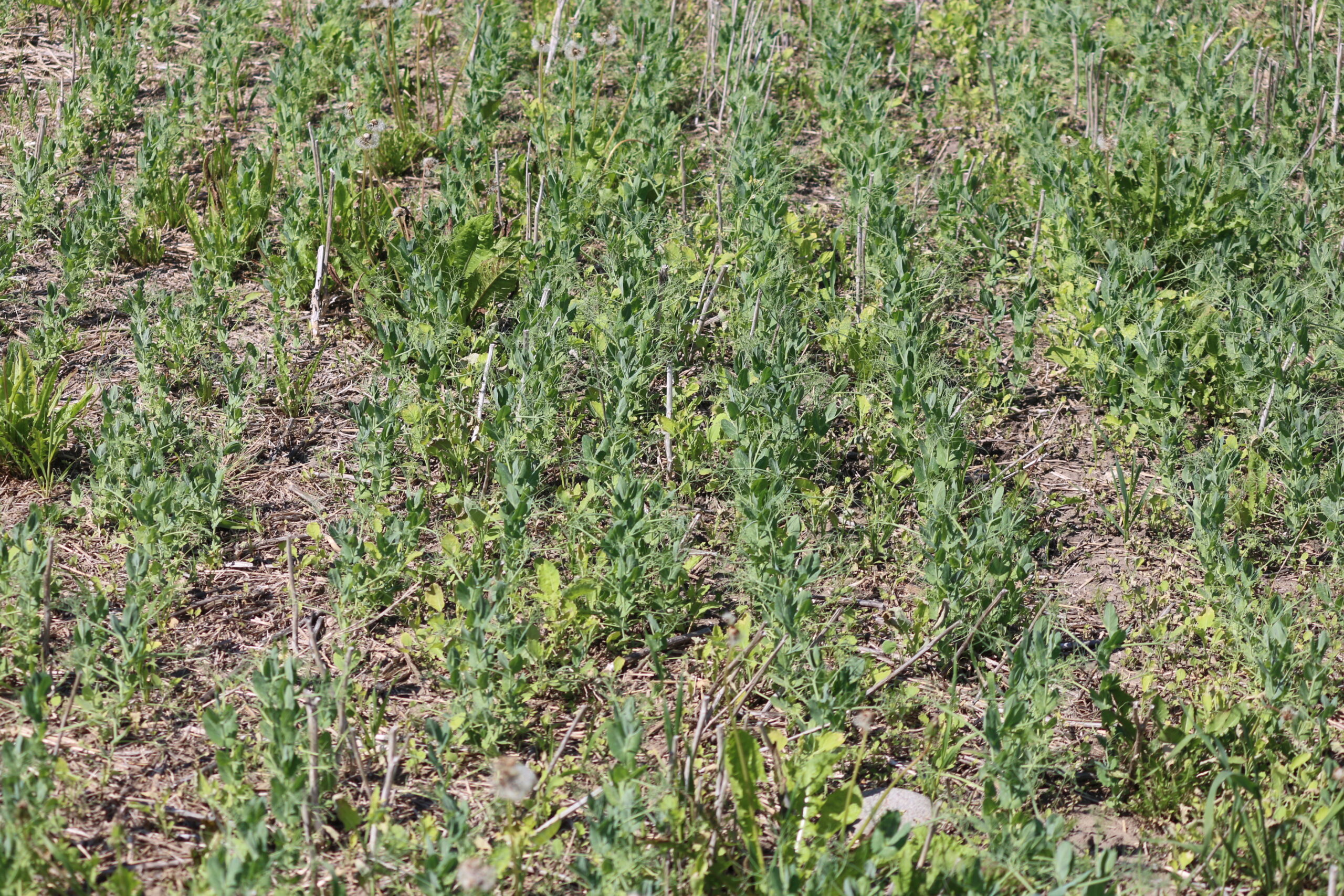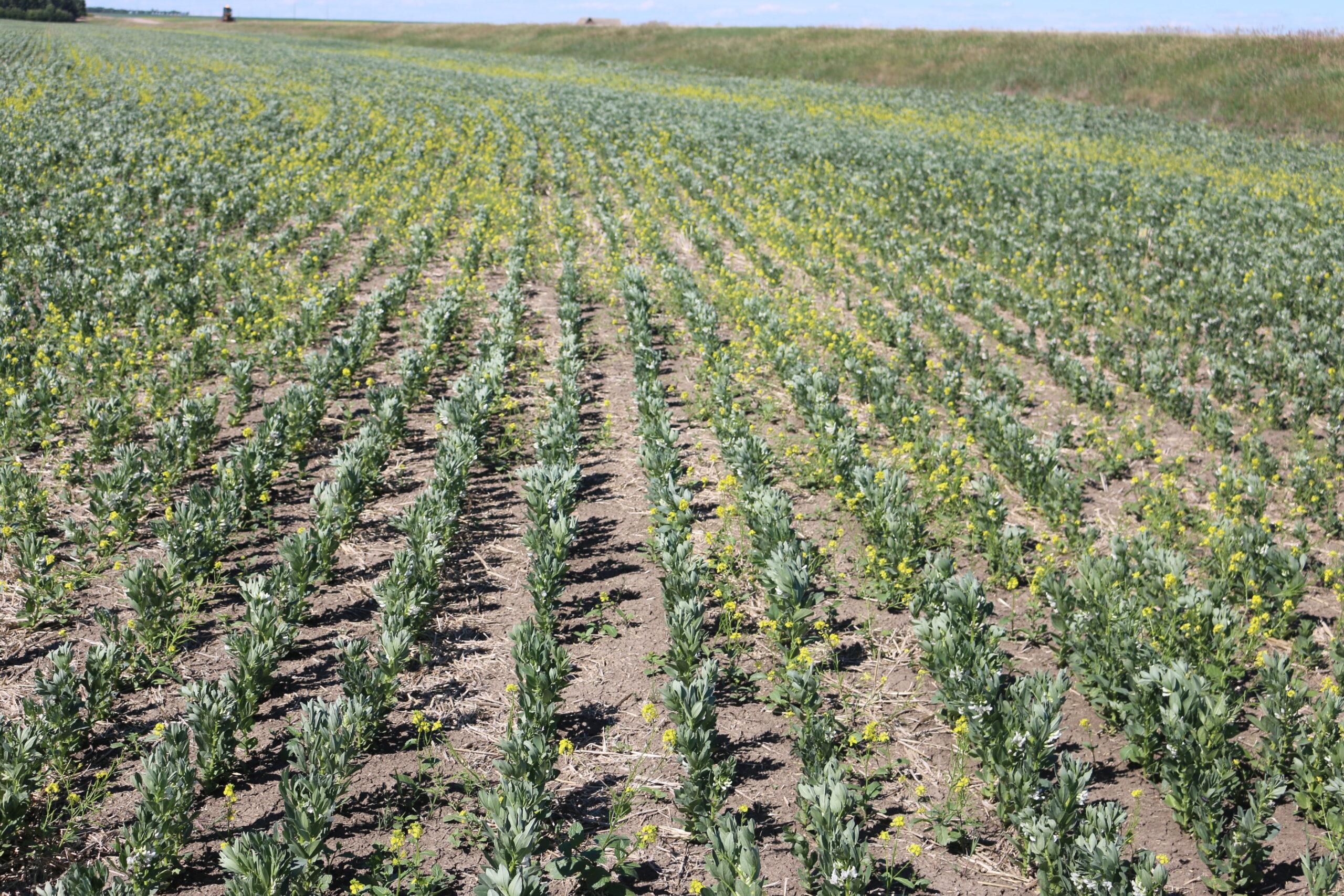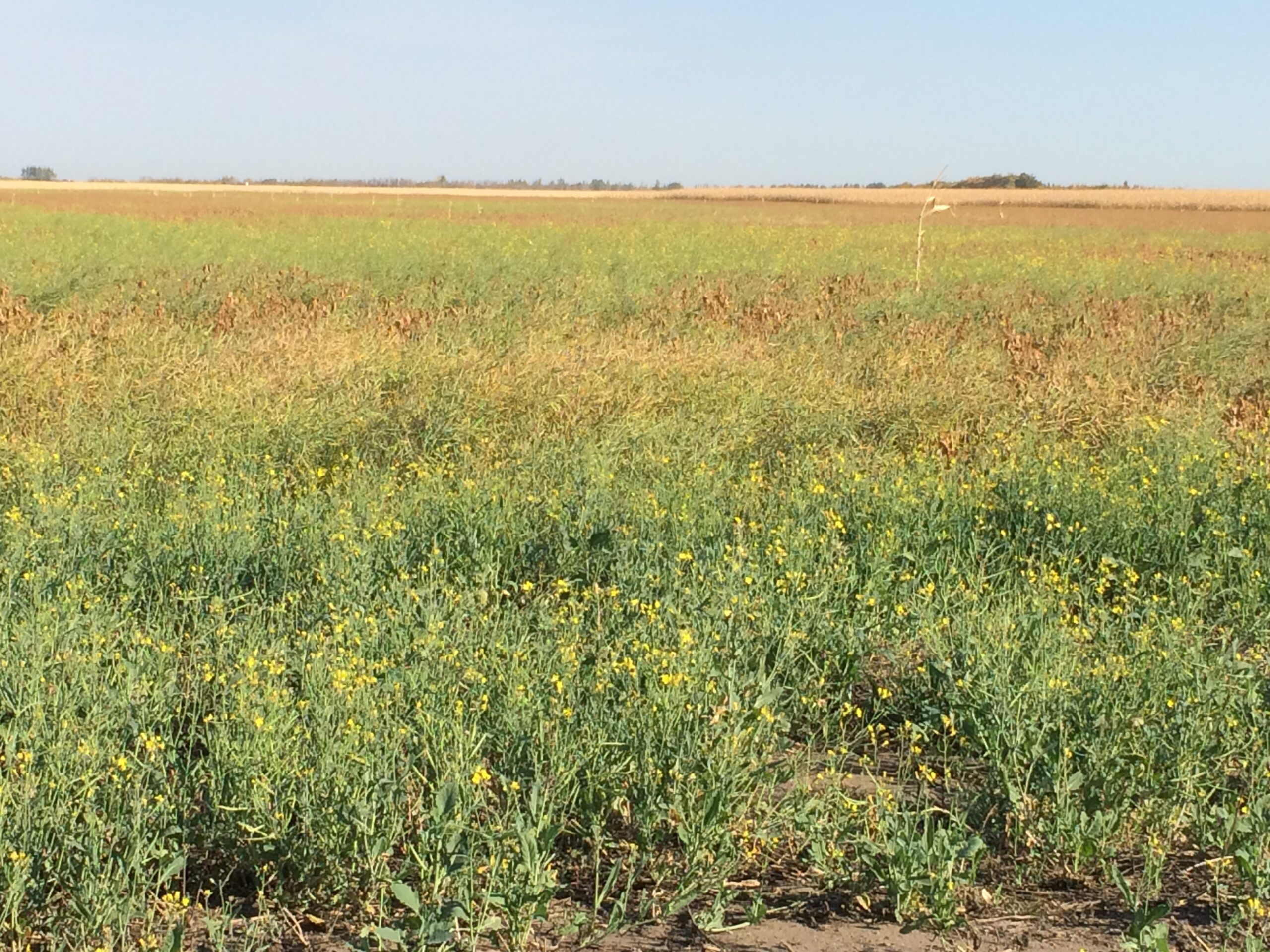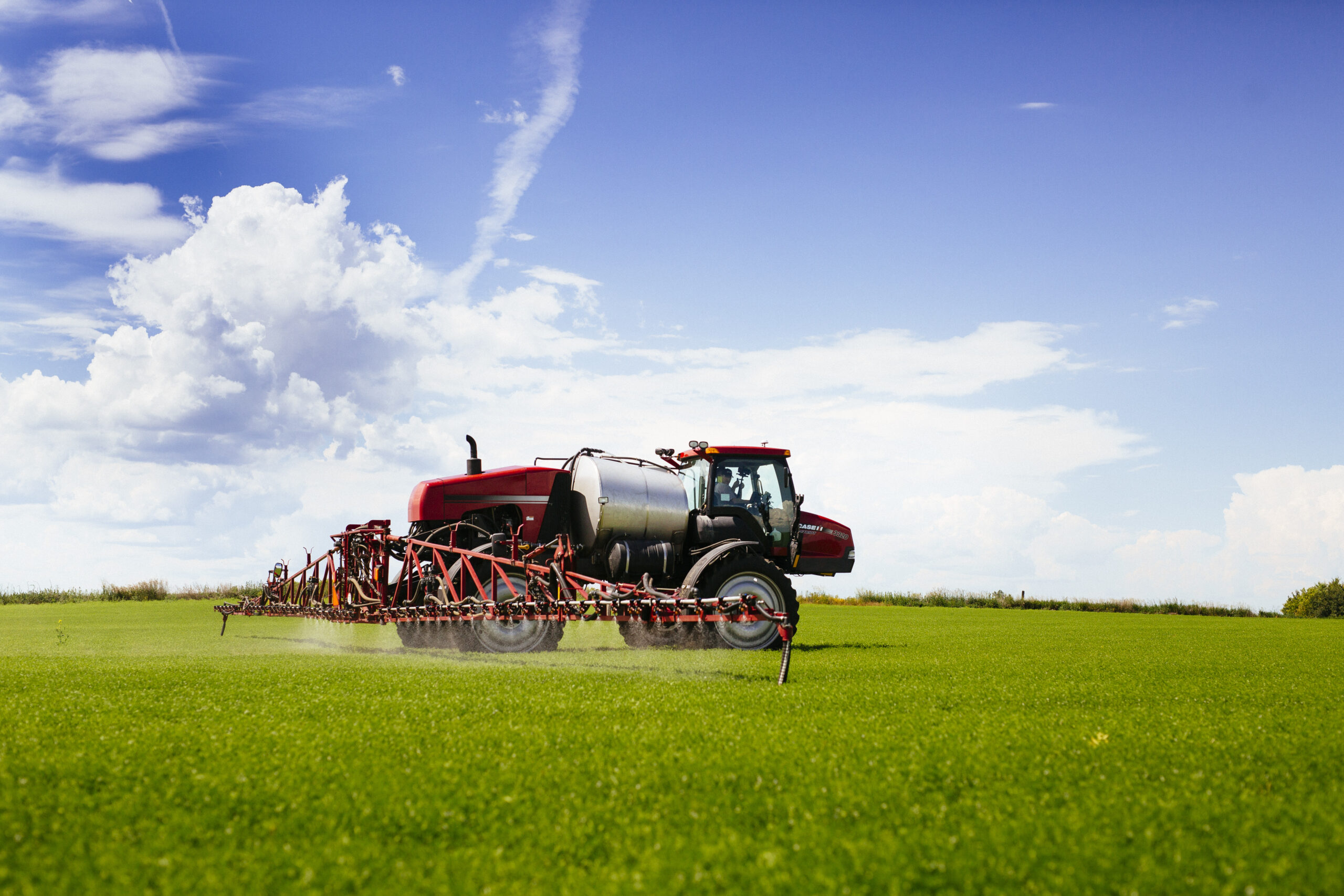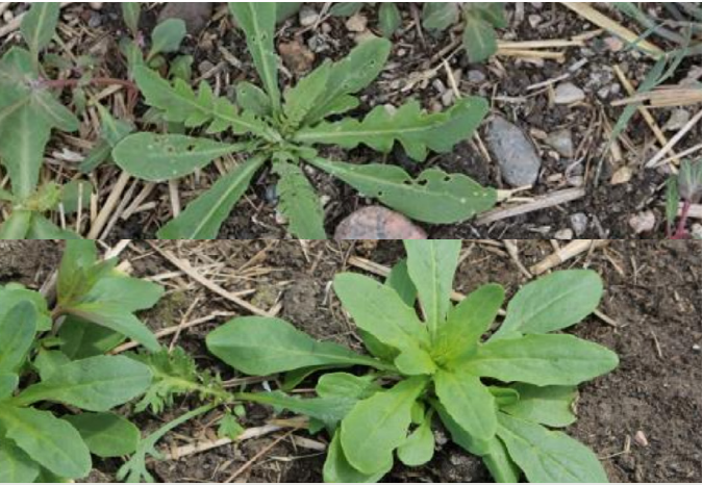Contributing Researchers: Dr. Chris Willenborg, Sid Darras, Eric Johnson, and Dr. Dilshan Benaragama
Introduction
As with most pulse crops, weed control in lentil is a big challenge. Lentils are short-statured and produce thin canopies, which makes it difficult for them to out-compete weeds throughout the growing season. On top of that, herbicide options are fairly limited in lentils, and the growing problem of herbicide-resistant weeds only narrows those choices for farmers.
To help lentil growers gain an edge over weeds, the Saskatchewan Pulse Growers (SPG) funded five weed research projects, conducted between 2016 and 2021. Three of the studies looked into the safety and efficacy of new herbicide options, and two investigated the potential of certain management practices to control weed escapes and resistant weeds.
Key Findings
- Weeds that escape a pre-seed residual herbicide can be successfully controlled in lentil using inter-row herbicide application.
- A fall-applied PRE-emergence herbicide application alone can often be as effective as layered fall PRE- and spring PRE- emergence strategy to control weeds in lentil.
- Early POST-emergence application of fluthiacet-methyl herbicides (i.e. Cadet®) in lentil can offer good control of some key weeds without hurting the crop or reducing yield.
- Despite their potential, amicarbazone (Group 5) and pyridate (Group 6) are not safe or effective weed control actives in lentil.
Studies on Weed Management Practices
When it comes to effective weed control in any crop, how and when herbicides are applied is as important as what products are applied. Researchers conducted two multi-year studies that looked at how herbicide timing and placement can affect weed control and yield in lentil.
Study 1: Inter-row herbicide application in lentil
Very little research has been done on the efficacy of inter-row herbicide application in pulses overall, never mind in lentil specifically. Inspired by Australian research on inter-row application of non- selective herbicides in lupin, researchers set out to determine if the same technique could be used successfully in lentil.
Year one of this study (2017) showed that lentil can tolerate inter-row spraying if it is done carefully so that crop rows are not inadvertently sprayed. Results from this year suggested inter-row herbicide use is best suited to control weed escapes following a pre-seed residual herbicide application, and the study was slightly redesigned to evaluate this concept in subsequent years.
In 2018, broad-spectrum herbicides were applied inter-row to lentils with and without a pre-seed herbicide treatment, and one treatment included a broadcast application of Ares™ as an industry standard check (Table 1). Unsatisfactory yield results of this trial lead to a tweaking of glyphosate rates for the 2019 and 2020 studies (Table 2).
Table 1. Treatment for inter-row herbicide application in lentil, 2018
| Treatment No. | PRE herbicide | POST herbicide | POST herbicide rate (g ai/ha) |
|---|---|---|---|
| 1 | None | None | |
| 2 | None | Glyphosate | 900 |
| 3 | None | Liberty® + Select® | 500 + 45 |
| 4 | None | Enforcer® M | 600 |
| 5 | None | Pyraflufen-ethyl + Sencor® | 4 + 281 |
| 6 | Heat® + pyroxasulfone | None | |
| 7 | Heat® + pyroxasulfone | Glyphosate | 900 |
| 8 | Heat® + pyroxasulfone | Liberty® + Select® | 500 + 45 |
| 9 | Heat® + pyroxasulfone | Enforcer® M | 600 |
| 10 | Heat® + pyroxasulfone | Pyraflufen-ethyl + Sencor® | 4 + 281 |
| 11 | Heat® + pyroxasulfone | Ares™ (industry standard) | 29 |
Note: grams of active ingredient per hectare (g ai/ha)
Table 2. Treatments for inter-row herbicide application in lentil, 2019 and 2020, Kernen Research Farm
| Treatment No. | Post-herbicide application #1/Rate (g ai/ha) | Post-herbicide application #2/Rate (g ai/ha) |
|---|---|---|
| 1 | None | None |
| 2 | Glyphosate / 225 | Glyphosate / 225 |
| 3 | Glufosinate / 500 | Glufosinate / 500 |
| 4 | Glyphosate / 225 + Fluroxypyr / 105 | Glyphosate / 225 + Fluroxypyr / 105 |
| 5 | None | Glyphosate / 225 |
| 6 | None | Glufosinate / 500 |
| 7 | None | Glyphosate / 225 + Fluroxypyr / 105 |
Conclusions
After analyzing the data of this evolving four-year experiment, researchers concluded that inter-row herbicide application is an effective way to control weed escapes in lentil, following a pre-seed residual herbicide application. Further, they found no difference in control levels between the different herbicide treatments they tested, or between early (mid-June) vs. late (early July) application timings— see Figures 1 and 2 for examples.

Statistically significant differences are indicated by different letters above the bars.

Statistically significant differences are indicated by different letters above the bars.
Study 2: Layering fall and spring PRE herbicides to manage Group 2 resistant wild mustard and kochia
The objective of this three-year study was to evaluate the efficacy of fall PRE and spring PRE herbicide combinations for managing Group 2 resistant kochia and wild mustard in lentil.
The study was conducted at the Kernen Research Farm (Sutherland heavy clay) in 2017, 2018 and 2021, and researchers noted that drought caused some variability in the results.
Using a randomized complete block design where each treatment was replicated four times, researchers treated test plots with various combinations of fall-applied pre-emergence residual herbicides (fall PRE) followed by spring-applied pre-emergence herbicides (spring PRE). They collected data on a number of points, including visual crop injury (crop phytotoxicity) and levels of weed control. The treatment combinations used in this study are shown in Table 3.
Table 3: Treatments for layering fall and spring PRE herbicides for managing Group 2 resistant kochia and wild mustard in lentil
| Fall PRE | Spring PRE | Per Rate (g ai/ha) | Per Rate (g ai/ha) | |
|---|---|---|---|---|
| 1 | None (untreated check) | None | 0 | 0 |
| 2 | None | Metribuzin + Fluthiacet | 0 | 103 + 2 |
| 3 | None | Metribuzin + Fluthiacet | 0 | 205 + 4 |
| 4 | Focus® | None | 168 | 0 |
| 5 | Focus® | Metribuzin + Fluthiacet | 168 | 103 + 2 |
| 6 | Focus® | Metribuzin + Fluthiacet | 168 | 205 + 4 |
| 7 | Fierce® (pyroxasulfone + flumioxazin) (NA14212) | None | 315 | 0 |
| 8 | Fierce® (pyroxasulfone + flumioxazin) (NA14212) | Metribuzin + Fluthiacet | 315 | 103 + 2 |
| 9 | Fierce® (pyroxasulfone + flumioxazin) (NA14212) | Metribuzin + Fluthiacet | 315 | 205 + 4 |
| 10 | Valtera™ | None | 105 | 0 |
| 11 | Valtera™ | Metribuzin + Fluthiacet | 105 | 103 + 2 |
| 12 | Valtera™ | Metribuzin + Fluthiacet | 105 | 205 + 4 |
| 13 | PL19581 | None | 453 | 0 |
| 14 | PL1958 | Metribuzin + Fluthiacet | 453 | 103 + 2 |
| 15 | PL1958 | Metribuzin + Fluthiacet | 453 | 205 + 4 |
| 16 | Pyroxasulfone | None | 150 | 0 |
| 17 | Pyroxasulfone | Metribuzin + Fluthiacet | 150 | 103 + 2 |
| 18 | Pyroxasulfone | Metribuzin + Fluthiacet | 150 | 205 + 4 |
1PL1958 is a liquid flumioxazin premix herbicide that is registered and sold in the United States as Panther® Pro. This product is not registered in Canada.
Conclusions

Crop phytotoxicity: Crop injury was assessed in 2017 and 2018 and all treatments were well below the maximum tolerable level of 10%, even when full-rate combinations were applied to the lentil plots. This is not to say there were no differences in crop phytotoxicity between treatments from year to year, or between 14 and 35 days after treatment (DAT) (when measurements were taken) – there were. But in all cases, crop injury was well within acceptable levels, regardless of treatment, which shows that a layered approach to herbicide application in the fall and spring is not harmful to the crop.
Weed control: While control of Group 2 wild mustard and kochia varied from year to year, researchers noted that a fall-applied PRE- emergence herbicide on its own was often as effective at controlling weeds as layering both fall PRE and a spring PRE herbicides. Indeed, they found that, in most cases, layering in a spring PRE application of metribuzin + fluthiacet did not improve weed control (Figures 3 and 4).

Studies on Potential New Herbicide Options For Lentil
In an ongoing effort to expand herbicide options for lentil growers, three studies were conducted to assess crop tolerance to various active ingredients and product formulations, as well as weed control efficacy.
Study 3: Weed control efficacy and tolerance of lentil to Group 14 herbicide actives and formulations
Early weed removal is key to protecting crop yield. This study looked at the potential of early post-emergence applications of pyraflufen-ethyl and fluthiacet-methyl, at different rates and different formulations, to control weeds without harming the crop.
This study was conducted at the Kernen Research Farm and built on previous greenhouse work, which indicated that suspension concentrate (SC) formulations might be less harmful to lentils than emulsifiable concentrate (EC) formulations. Using a randomized complete block design, where each treatment was replicated four times, researchers applied 12 post-emergence herbicide treatments to CDC Maxim lentils at the two- to three-node stage (Table 4).
Table 4. Treatments for evaluating lentil tolerance and weed control efficacy of pyraflufen and fluthiacet-methyl.
| Treatment No. | Herbicide & Formulation Type | Form | Rate (g ai/ha) | Adjuvant | Rate (% v/v) | Growth Stage |
|---|---|---|---|---|---|---|
| 1 | Untreated check | |||||
| 2 | Pyraflufen-ethyl EC | 25 | 2 | Agral® 90 | 0.25 | 2-3 node |
| 3 | Pyraflufen-ethyl EC | 25 | 4 | Agral® 90 | 0.25 | 2-3 node |
| 4 | Pyraflufen-ethyl EC | 25 | 8 | Agral® 90 | 0.25 | 2-3 node |
| 5 | Pyraflufen-ethyl SC | 20 | 2 | Agral® 90 | 0.25 | 2-3 node |
| 6 | Pyraflufen-ethyl SC | 20 | 4 | Agral® 90 | 0.25 | 2-3 node |
| 7 | Pyraflufen-ethyl SC | 20 | 8 | Agral® 90 | 0.25 | 2-3 node |
| 8 | Cadet® (fluthiacet- methyl) EC | 109 g ai/L | 2 | Agral® 90 | 0.25 | 2-3 node |
| 9 | Cadet® (fluthiacet- methyl) EC | 109 g ai/L | 4 | Agral® 90 | 0.25 | 2-3 node |
| 10 | Cadet® (fluthiacet- methyl) EC | 109 g ai/L | 8 | Agral® 90 | 0.25 | 2-3 node |
| 11 | F9140-8 (fluthiacet- methyl) SC | 216 g ai/L | 2 | Agral® 90 | 0.25 | 2-3 node |
| 12 | F9140-8 (fluthiacet- methyl) SC | 216 g ai/L | 4 | Agral® 90 | 0.25 | 2-3 node |
| 13 | F9140-8 (fluthiacet- methyl) SC | 216 g ai/L | 8 | Agral® 90 | 0.25 | 2-3 node |
| 14 | Untreated weed- free check |
Pyraflufen-ethyl is a Group 14 active ingredient found in pre-seed herbicides, such as Conquer® II, Thunderhawk™ and GoldWing®, not all of which are currently registered for use before lentil.
Conclusions
Crop safety: Lentils do not have good tolerance to pyraflufen- ethyl, regardless of rate or formulation applied. In all cases, these treatments resulted in unacceptable levels of chlorosis, from which the crop never recovered. Conversely, fluthiacet-methyl appears to provide acceptable crop safety – although chlorosis over 10% did occur at 14 days after application (DAA) in some cases, this subsided to acceptable levels by 28 DAA (Figure 5).

Thresholds of acceptable crop damage are based on the Canadian Weed Science Society (CWSS) phytotoxicity rating scale. The blue line represents 10% damage, the red line represents 30% damage. Damage below 10% is considered an acceptable level of crop injury. Damage between 10 and 29% is considered unacceptable, and anything beyond 30% is considered severe crop injury.
Weed control efficacy: Since the lentils treated with pyraflufen-ethyl failed to thrive, weed control efficacy was measured only in those plots treated with fluthiacet-methyl.
Using the CWSS phytoxicity rating scale to measure control of stinkweed, red root pigweed, wild mustard, wild buckwheat and common lamb’s quarters, researchers had mixed results. No herbicide treatment was effective against wild buckwheat or wild mustard, and higher rates of fluthiacet-methyl products were needed to achieve good control of the other weeds. Formulation also played a role in weed control. Higher rates of Cadet ® EC gave good control of lamb’s quarters, but the SC formulation (F9140-8) only suppressed this weed (Figure 6).

Key CWSS phytotoxicity ratings are indicated by the blue and red lines. Ratings less than 60% indicates poor weed control, between 60 and 79% indicates weed suppression, between 80 and 90% is good to very good control and 91% and above indicates excellent weed control.
Crop yield: Due to its crop safety issues, pyraflufen-ethyl had already shown it was not a good fit for lentil crops. If only to emphasize the point, yield losses from pyraflufen-ethyl applied at the 2x rate resulted in an average 86% yield loss over the untreated check.
However, lentil showed good tolerance to fluthiacet-methyl, an active ingredient that also provided reasonable to excellent control of some key weeds without negatively impacting crop yield (Figure 7).

Study 4: Weed control efficacy and tolerance of lentil to amicarbazone
Amicarbazone is the Group 5 active ingredient found in Xonerate® herbicide. The potential of this active for wild mustard control in lentil was identified in a preliminary greenhouse study done in 2016, which found that the ED50 of amicarbazone was 897 g ai/ha for lentil and 61 g ai/ha for wild mustard. ED50 is a dose-response indicator—it specifies the dose required to achieve 50% of the desired response in 50% of the population, otherwise known as the effective dose.
In this case, the greenhouse ED50 revealed a lentil-to-mustard selectivity ratio of 14.7:1, which researchers thought promising enough to justify field studies at Scott (loam) and Kernen (heavy clay) in 2017 and 2018.
Using a randomized complete block design with four replicates, the 2017 study compared the weed control efficacy of PRE and POST applications of amicarbazone at various rates and formulation types (Table 5). This study revealed some variability in POST weed control efficacy, so surfactants were added to POST applications in 2018 (Table 6). CDC Maxim lentils were used in these trials, and the target weeds were wild mustard and kochia.
Table 5. Treatments for evaluating lentil tolerance and weed control efficacy of amicarbazone, 2017
| Treatment No. | Herbicide | Concentration (g/l) / Formulation | Timing | Rate (g ai/ha) |
|---|---|---|---|---|
| 1 | Weedy check | |||
| 2 | Amicarbazone | 480 SC | PRE | 50 |
| 3 | Amicarbazone | 480 SC | PRE | 100 |
| 4 | Amicarbazone | 450 SC | PRE | 150 |
| 5 | Amicarbazone | 480 SC | PRE | 200 |
| 6 | Amicarbazone | 480 SC | PRE | 300 |
| 7 | Amicarbazone | 480 SC | PRE | 400 |
| 8 | Amicarbazone | 480 SC | POST | 50 |
| 9 | Amicarbazone | 480 SC | POST | 100 |
| 10 | Amicarbazone | 480 SC | POST | 150 |
| 11 | Amicarbazone | 480 SC | POST | 200 |
| 12 | Amicarbazone | 480 SC | POST | 300 |
| 13 | Amicarbazone | 480 SC | POST | 400 |
| 14 | Weed-free check |
Table 6. Treatments for evaluating lentil tolerance and weed control efficacy of amicarbazone, 2017
| Treatment No. | Amicarbazone Rate (g ai/ha) | Surfactant | Surfactant Rate (% v/v) |
|---|---|---|---|
| 1 | Weedy check | None | – |
| 2 | 75 | None | – |
| 3 | 125 | None | – |
| 4 | 150 | None | – |
| 5 | 250 | None | – |
| 6 | 75 | Agral® 90 | 0.25 |
| 7 | 125 | Agral® 90 | 0.25 |
| 8 | 150 | Agral® 90 | 0.25 |
| 9 | 250 | Agral® 90 | 0.25 |
| 10 | 75 | Merge® | 0.5 |
| 11 | 125 | Merge® | 0.5 |
| 12 | 150 | Merge® | 0.5 |
| 13 | 250 | Merge® | 0.5 |
| 14 | 75 | Liberate® + ammonium sulphate | 1.6 + 1.2 |
| 15 | 125 | Liberate® + ammonium sulphate | 1.6 + 1.2 |
| 16 | 150 | Liberate® + ammonium sulphate | 1.6 + 1.2 |
| 17 | 250 | Liberate® + ammonium sulphate | 1.6 + 1.2 |
Conclusions
Results differed, sometimes dramatically, from year to year and between the two research sites. For instance, in 2017 at Scott, PRE and POST rates of amicarbazone greater than 150 g ai/ha resulted in unacceptable levels of crop injury. At Kernan, this was also the case for PRE applications, however POST applications at rates greater than 150 g ai/ha did not cause any crop injury and were even necessary to achieve season-long weed control.
The 2018 study showed that amicarbazone was effective at suppressing wild mustard and kochia, with no major improvements observed between different rates. The addition of each surfactant tested did increase weed control, but they also increased crop injury and reduced plant vigour.
After looking at data from both years and both sites—the incidence of crop injury, reduced crop biomass (Kernen), and yield loss (Scott)— researchers concluded that the selectivity of amicarbazone is not sufficient enough to warrant further research for POST application in lentil.
Study 5: Pyridate tolerance in lentil
Pyridate is a Group 6 broadleaf herbicide that has been used in horticultural crops for many years. It is a contact herbicide with no residual, making it a good potential tank-mix partner with glyphosate for pre-seed burndown in pulse crops.
In Canada, pyridate is sold as Tough® 600EC for pre-emergence use in several crops, including lentil, to control key weeds like wild mustard, common lamb’s quarters and redroot pigweed.
This study, conducted in 2018 at the Kernen Research Farm, evaluated tolerance to pyridate POST applications made at the two- to three- node stage in CDC Maxim lentils. The product was applied at rates of 900 (1x) and 1,800 (2x) g ai/ha, and compared against Sencor® 75DF, the industry standard.
Conclusions
Lentils are not able to tolerate a POST application of pyridate at rates above 225 g ai/ha, which is far short of even the half rate. Indeed, applying pyridate at a rate that would achieve acceptable weed control would result in unacceptable crop injury and yield loss. This study was done using CDC Maxim lentils—future work could investigate whether different lentil cultivars are better able to tolerate a POST application of pyridate.

Enhancing weeds science in pulse crops: Towards a robust strategy for long-term weed management
Dr. Christian Willenborg University of Saskatchewan – Dept. of Plant Sciences Objective
